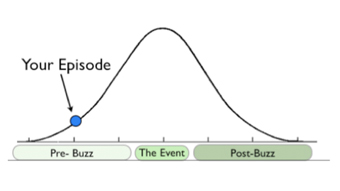A few weeks ago I signed a contract to join YouTube network, Rightster. I’m intrigued to see how it goes, having always been a fierce believer in staying independent, but one of the immediate positive effects was being able to get an invitation to YouTube’s Sports Lab meet up.
There were around 50 plus sports channels from across the UK in attendance at the event, which took place at Google’s YouTube Partner space in central London. The day consisted of hands on video work, seeing around the space they have created for creators, and then workshops where their resident experts go through tips for us on how to improve and grow our channels.
Here are the 8 biggest take aways I got from the day, which was especially tailored to sports channels due to the different constraints they face. Whether it be from digital rights, access or resources, sports channels such as mine definitely do face a different set of challenges in comparison to any other type of channel.
1) You Must Upload Regularly
This seems pretty obvious and I’ve always known it, however, what I didn’t know was that if you do upload less frequently, the algorithm is automatically weighted to make your content less likely to appear in subscriber’s feeds when you do upload. I assume this is because people are subscribed to so many channels these days that it’s physically impossible to show every upload in people’s feeds (in similar fashion to Facebook choosing what to display and what not to display).
Additionally, they also strongly advised to have a strategy year-round; plan in advance for the off-season so you are continually pushing videos.
This definitely provided food for thought for me, especially as someone who doesn’t currently have scheduled programming and uploads on a sporadic basis.
2) Speed is of the Essence
YouTube said that around sports events specifically, you have around a 72 hour window to get something online. As everything moves more and more real-time (I get surprised if I search for a basketball highlight within 10 minutes of it happening and it’s not online), channels must adapt to this and ensure if they are covering specific events/competitions that their content is out their as quickly as possible.
I’ll never forget sprinting home in the pissing down rain back in 2010 after I’d filmed Kobe saying he would easily beat LeBron in a one on one, knowing that if I got it up first it had viral potential. It paid off – the video has now done over 2 million views and was all over US television over the next few days.
Contrastingly, I was also filming when Boris Johnson hit an over the head basketball trick shot last year. I got lazy, went for lunch, figured I would upload it that evening. The result? ITN got it online immediately, and broke the million views barrier, whilst mine hasn’t even broken 4,000 (yeah, I’ve embedded it below – every little helps!).
Speed is everything, especially when it comes to sports.
3) Use Google Trends to Find What People Are Searching For
A quick glance at Google Trends will show you what is being searched for the most, around the world, or in a specific country, right now.
Use this to your advantage – what content could you create based around this topic? An obvious example that comes to mind was ‘the Harlem Shake’ craze that started last year. A number of basketball teams jumped on this trend, and it resulted in a huge spike of traffic to their channels and long term growth of their audience.
There is also a YouTube Trends dashboard, though it’s definitely not as detailed as Google trends, it is worth a look every now and again. The YouTube Trends blogspot also has some interesting analysis sometimes.
4) Enable ContentID to Take Advantage of Fans Evangelizing Your Content
This was also something I’d never even thought about. On the rare occasions I’ve had videos that have gone “viral”, I’ve been very protect over those videos, and the moment I see people ripping it I’d flag it and report to YouTube to have it taken down.
What YouTube recommends in some cases, is just to monetize those videos on other people’s channels through Content ID. It means people can use your footage, edit it into compilations or whatever else, whilst you are the one getting paid for those views.
5) Collaboration is Incredibly Important & Easier Than You Think
One of the main purposes of the day was to network with other channels and try to come up with potential collaborations. I’ve long known YouTube believes collaborations is one of the best ways of growing your audience, however, have always struggled with that concept if you are a sports channel with no real “personality” as a front.
If you are a video blogger collaborations are easy, right? You just go and film a video with another channel and both sit their and talk. If you’re a sports channel that shows highlights however, it is a little more tricky.
Interestingly though, it is possible. They recommended using talent from each respective sport (if it’s a cross sport collaboration) to do different sporting challenges.
For example, one of the things we spoke about in our group was me getting a GB basketball player, like a Luol Deng or Pops Mensah-Bonsu, and getting them to team up with some professional footballers for trick shots. It could be cross-pollinated across both channels.
6) Have a Personality
Further to the comment in number five about not having a ‘personality’ to host your videos – YouTube’s recommendation is plain and simple; if you don’t have one, get one.
They couldn’t emphasise this point enough. Highlights and whatever else are great, but what really grows an audience is a personality that people can connect with and become a fan of.
I started this last year with my Hoopsfix Vlog channel, despite me being incredibly uncomfortable being in front of the camera, I recognise how important it is for the growth of my business.
7) Ask Yourself These 10 Questions Before Every Upload
YouTube gave us a checklist of ten questions to ask ourself about every video or show we create, which I will definitely bear in mind for future content.
They are as follows;
-Is it shareable?
Exactly as you’d imagine – will people want to share this with their friends after they watch it?
-Is it conversational?
Is there an element to your video that encourages conversation by directly addressing your audience?
-Is it interactive?
Is there a way to involve the audience in how the show is created, for example, replying to comments via video.
-Is it consistent?
Do you have strong recurring elements, or more importantly, a schedule – will people know when you are uploading?
-Is it targeted?
Have you thought about who your audience is for this particular video and how you can make it even more specific to them?
-Is it sustainable?
If the audience does love it, can you create more of it? Try not to be a one hit wonder.
-Is is discoverable?
Is it relevant to current affairs, will it come up in common and trending searches?
-Is it accessible?
If a new viewer watches your video, will they instantly get it, or do they need prior videos for context? Make it be able to stand alone.
-Is it collaborate-able?
Can you feature guests and collaborate with other channels on a regular basis?
-Is it authentic?
Are you being true to your brand?
8) Use Tent Pole Programming
 I pointed to this as a bonus tip in my post on how to increase YouTube views and still haven’t used it to maximum advantage.
I pointed to this as a bonus tip in my post on how to increase YouTube views and still haven’t used it to maximum advantage.
As I said then, this is where you align your content strategy with big events which are scheduled in the future. You release your video ahead of the event (see image), creating pre-buzz and helping to rank for the term you know will be searched a lot after (or as) the event has happened.
This is really relevant to sports channels as there are so many marquee events in every sport that dot the calendar year round. YouTube recommends to build a programming schedule that capitalises on the events that people want to see.
For me, that would include all the England and GB Junior National team events that are happening this summer; I could do preview videos of the teams, for example.
—
So those are my lessons learned – please let me know in the comments if you have any other examples or tips that you’ve seen work particularly well with sports channels.
As always – check out the YouTube playbook for more tips, it is FULL of great ideas.


